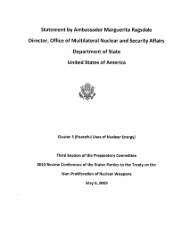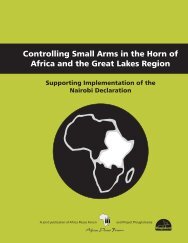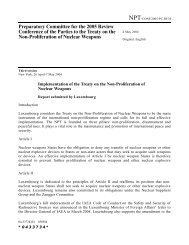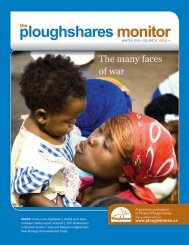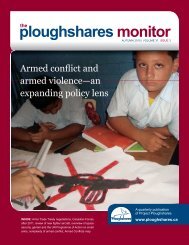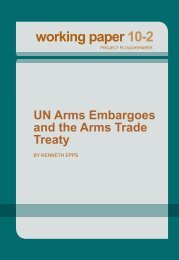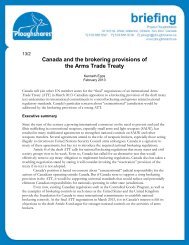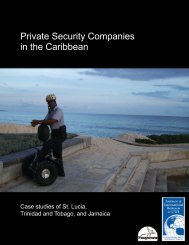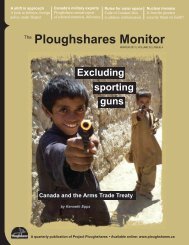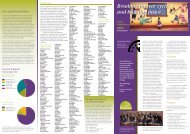Addressing Armed Violence in East Africa.pdf - Project Ploughshares
Addressing Armed Violence in East Africa.pdf - Project Ploughshares
Addressing Armed Violence in East Africa.pdf - Project Ploughshares
You also want an ePaper? Increase the reach of your titles
YUMPU automatically turns print PDFs into web optimized ePapers that Google loves.
<strong>Address<strong>in</strong>g</strong> <strong>Armed</strong> <strong>Violence</strong> <strong>in</strong> <strong>East</strong> <strong>Africa</strong>3. KenyaAdvice was given concern<strong>in</strong>g disarmament exercises:• Human rights organisations were identified as gett<strong>in</strong>g <strong>in</strong> theway of giv<strong>in</strong>g the government a chance to take away guns.• “Government has legitimate cause to remove guns, but itshould be done without excessive force.”• Measures to control guns were suggested, such as register<strong>in</strong>gall guns <strong>in</strong> the community.• “People have <strong>in</strong>vested <strong>in</strong> their guns and don’t want to givethem up until security is better assured.”Some of those <strong>in</strong>terviewed stated a need for a deeper religiouscommitment to end the violence:• “Communities also need evangelisation, the Gospel. Pastorsneed support to do this.”ObservationsAs <strong>in</strong>dicated by the variety of factors and motivations forviolence related <strong>in</strong> <strong>in</strong>terviews, it is not possible to reducearmed violence among pastoralists by identify<strong>in</strong>g a group ofperpetrators of violence and focus<strong>in</strong>g on them. The violenceis embedded <strong>in</strong> a rich cultural web of long-held practices nowdistorted by a range of factors, not the least of which is thewidespread <strong>in</strong>troduction of automatic weapons <strong>in</strong> the secondhalf of the 20 th century.1. The Marakwet decision to reduce the practice of dowry orbride price seems to have significantly reduced the <strong>in</strong>centiveto raid from their neighbours and has <strong>in</strong>creased <strong>in</strong>termarriagewith the Pokot. This and a range of other <strong>in</strong>itiatives forpeace give hope that peace is atta<strong>in</strong>able between pastoralistcommunities.2. Solutions must go beyond <strong>in</strong>terrupt<strong>in</strong>g the supply of guns<strong>in</strong> conflict zones and remov<strong>in</strong>g them through disarmamentprocesses. Forced disarmament may be counter-productive.Keith Krause from Small Arms Survey has called the needed<strong>in</strong>terventions second-generation strategies:Second-generation attempts to deal with the small armsproblem are probably more important and thornierbecause those of us who come out of an arms control ordisarmament background have so much to learn from thedevelopment, humanitarian, public health, and crimescontrol communities. When you start to talk aboutsecond-generation measures, you shift your focus to thedemand-side of the equation, to what drives people to seekand to hold, use, or misuse weapons whether for personal orcommunity security or with crim<strong>in</strong>al and violent <strong>in</strong>tent. 5The factors <strong>in</strong>fluenc<strong>in</strong>g the escalation of violence and demandfor guns among Kenyan pastoralist communities fall <strong>in</strong>to thissecond-generation category: disease and drought, conflicts withthose <strong>in</strong> nearby settled towns and trad<strong>in</strong>g centres along roads,remoteness from central government attention and decisionmak<strong>in</strong>g, climate-<strong>in</strong>fluenced shr<strong>in</strong>kage of graz<strong>in</strong>g lands and watersources, few roads and public services, and <strong>in</strong>creas<strong>in</strong>g crimemet by <strong>in</strong>adequate polic<strong>in</strong>g. 6 Even the traditional motivationsof cattle raid<strong>in</strong>g for pride, wealth and dowry are giv<strong>in</strong>g way tostolen cattle end<strong>in</strong>g up on trucks bound for slaughterhouses andmeat exporters.3. Gun violence is both a harb<strong>in</strong>ger of change and a sign ofthe impact of that change on traditional societies <strong>in</strong> <strong>Africa</strong>.If the devastat<strong>in</strong>g violence caused by these weapons is to bere<strong>in</strong>ed <strong>in</strong>, the number of guns must be reduced, while the gunsrema<strong>in</strong><strong>in</strong>g come under strict social controls. But disarmamentis only part of the solution; development and security reformare also necessary. Disarmament <strong>in</strong>itiatives must be carried out<strong>in</strong> all contend<strong>in</strong>g communities, and <strong>in</strong>tegrated <strong>in</strong>to communitydevelopment and specific peace <strong>in</strong>itiatives to create a more secureenvironment that <strong>in</strong> turn will allow for <strong>in</strong>creased development.This is the complex reality <strong>in</strong> which WVK, with its civil societyand government partners, is undertak<strong>in</strong>g peacebuild<strong>in</strong>g <strong>in</strong> theNorth Rift Valley of Kenya.4. An <strong>in</strong>herent problem with these <strong>in</strong>terconnect<strong>in</strong>g sectoral<strong>in</strong>itiatives is discern<strong>in</strong>g the impact of each <strong>in</strong>itiative and of the<strong>in</strong>fluence of other factors, <strong>in</strong>clud<strong>in</strong>g such imponderables asra<strong>in</strong>fall. Complex problems do not have predictable timel<strong>in</strong>esor project outcomes. Donors look<strong>in</strong>g to have an impact throughpeacebuild<strong>in</strong>g programmes may need to shift their sights fromresults-based management and log frame matrixes that predictspecific outcomes <strong>in</strong> specific periods. Donors should be preparedto be flexible as the context changes.5 K Krause, Lead paper, Session One “Controll<strong>in</strong>g Small Arms and LightWeapons”, Contemporary Threats to International Peace and Security, Waterloo,<strong>Project</strong> <strong>Ploughshares</strong>, 2007, p 24, http://www.ploughshares.ca/libraries/Build/30thAnnSymposium.<strong>pdf</strong>6 J Bevan, Crisis <strong>in</strong> Karamoja: <strong>Armed</strong> <strong>Violence</strong> and the Failure of Disarmament<strong>in</strong> Uganda’s Most Deprived Region, Small Arms Survey, Geneva, 2008, pp 28–29,http://www.reliefweb.<strong>in</strong>t/rw/RWFiles2008.nsf/FilesByRWDocUnidFilename/ASIN-7GJSQY-full_report.<strong>pdf</strong>/$File/full_report.<strong>pdf</strong>32



